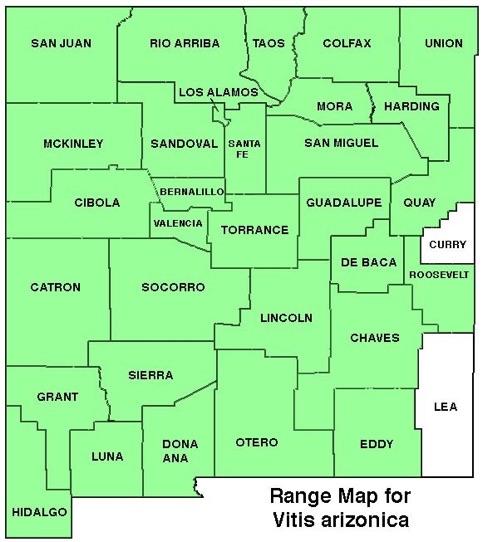WILDFLOWERS OF NEW MEXICO

With woody stems reaching 7–20 feet long, this vigorous vine climbs by twining tendrils through shrubs and into trees, and sprawls across open ground. Pyramidal clusters with numerous tiny, whitish-green flowers produce an abundance of small, purple-black grapes. Note the heart-shaped, toothed leaves, usually with lobes. In autumn, the leaves turn scarlet before falling.
FLOWER: April–July. Dense, branching clusters 2–4 inches long with tiny whitish-greenish flowers form in a pyramidal array on the stem opposite the leaves. Each flower has 5 minute petals and nectar glands to attract native flies, bees, and other small pollinators. Flowers are unisexual with either stamens (male) or a pistil (female). Unlike cultivated vineyard grapes with perfect flowers, V. arizonica has male and female flowers on separate plants. Grapes mature in August.
LEAVES: Alternate with twining tendrils opposite the leaves. Blades 1–5 inches long and broad (3–12 cm), with irregularly teeth, often with three lobes; deciduous.
HABITAT: Sandy, gravelly soils of canyons, riparian areas, drainages with reliable water; desert scrublands, foothills, pinyon-juniper woodlands.
ELEVATION: 3,500–7,000 feet.
RANGE: AZ, NM, NV, TX, UT.
SIMILAR SPECIES: 2 other look-alike grape species, V. acerifolia and V. riparia, in ne. NM have slightly different tendril and flower characteristics.
NM COUNTIES: Nearly statewide ,except e. plains, in low- to mid-elevations, periodically moist soils: Bernalillo, Catron, Chaves, Cibola, Colfax, De Baca, Dona Ana, Eddy, Grant, Guadalupe, Harding, Hidalgo, Lincoln, Los Alamos, Luna, McKinley, Mora, Otero, Quay, Rio Arriba, Roosevelt, San Juan, San Miguel, Sandoval, Santa Fe, Sierra, Socorro, Taos, Torrance, Union, Valencia.









CANYON or ARIZONA GRAPE
VITIS ARIZONICA
Grape Family, Vitaceaa
Perennial, deciduous vine


















THE CONTENTS OF THIS WEBSITE ARE COPYRIGHTED AND CANNOT BE USED
WITHOUT PERMISSION OF GEORGE OXFORD MILLER
















EMAIL ME


















Grape arbor, El Malpais National Monument



























Grapes climb with tendrils that twist around twigs.

On wild grapes, male and female lowers are on separate plants.
Leaves have irregular teeth and often have three lobes.







